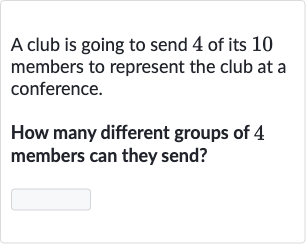Full solution
Q. A club is going to send of its members to represent the club at a conference.How many different groups of members can they send?
- Calculate factorial of : To solve this problem, we need to calculate the number of combinations of members taken at a time. This is a combinatorial problem where order does not matter, and we can use the combination formula which is , where is the total number of items, is the number of items to choose, and “” denotes factorial.
- Calculate factorial of : First, we calculate the factorial of , which is .
- Calculate factorial of difference: Next, we calculate the factorial of , which is .
- Apply combination formula: Then, we calculate the factorial of the difference between and , which is .
- Substitute factorial values: Now we can plug these values into the combination formula: .
- Simplify the equation: Substitute the factorial values into the formula: .
- Perform division and multiplication: We can simplify the equation by canceling out the common factors in the numerator and the denominator. The in the denominator cancels with the same factors in the numerator, leaving us with: .
- Final result: Perform the division and multiplication: .
- Final result: Perform the division and multiplication: .Therefore, the club can send different groups of members to represent it at the conference.
More problems from Counting principle
QuestionGet tutor help
QuestionGet tutor help
QuestionGet tutor help
QuestionGet tutor help
QuestionGet tutor help
QuestionGet tutor help
QuestionGet tutor help
QuestionGet tutor help
QuestionGet tutor help



